Menu
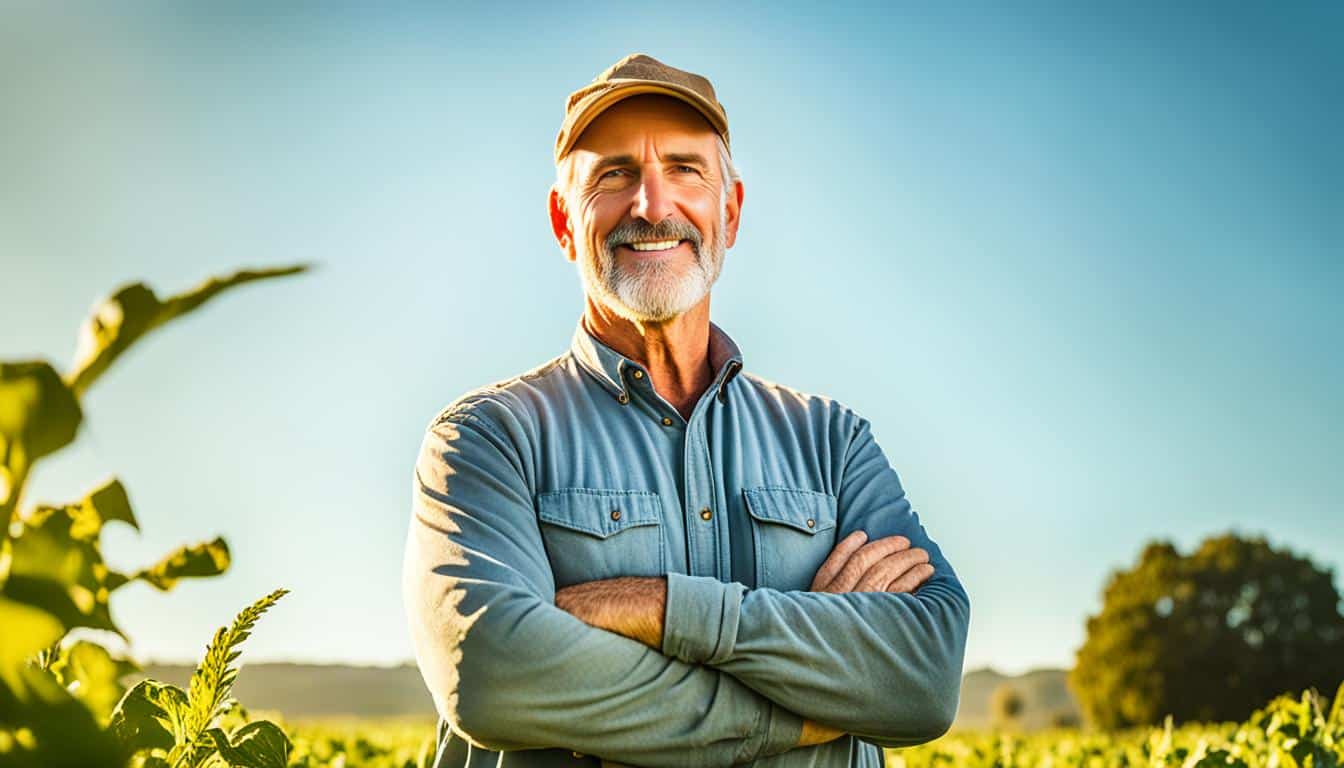
Did you know 2,000 acres of farming land change use every day? This highlights the need to make farming communities stronger. By 2040, it’s estimated we could lose 18.4 million acres more. So, it’s critical to focus on resilience.
In Nebraska, agriculture is a complex system that includes growing, processing, and selling food. It shows how a problem in one area can affect the world. Examples include trade issues, droughts, and problems in the supply chain.
Agriculture must be able to handle problems without major harm. This becomes even more vital as we will likely need to grow 70% more food by 2050. Solving issues like bad weather, soil damage, and pest invasions is key for a robust farming future.
To become stronger, farming needs to keep growing sustainably. It must also welcome new ideas and use resources carefully. Craig Allen, from the Center for Resilience in Agricultural Working Landscapes, talks about how farming must transform. It must be able to change in response to environmental, economic, social, and policy challenges.
For farming communities, being resilient is key. It helps them balance between being productive and staying sustainable. By using good farming resilience strategies, we make sure these areas are ready for big changes. Organic Agriculture, Biodynamics, and other methods help these places thrive. They also make selling at farmers’ markets and growing in community gardens possible.
The Green Revolution after World War II brought big growth in farming. But it also caused harm. It led to more bugs in crops and less plant variety. This tells us how vital it is to be smart and careful in farming. Strong farming resilience strategies are our best defence against these problems.
Now, with the world growing closer, farmers face more financial battles. It’s crucial to build up the strength of farming communities, especially as we need to produce more food. Science and old farming tricks offer a way to help the environment and keep farming going strong. These methods help ensure our farms can keep producing food.
Farming plays a big part in climate change, making up a quarter of all greenhouse gases. We need to fight this for a better future. With the planet warming up, using our land better is a must. By 2050, farm production might drop by 17%. This makes it even more urgent to be ready for change. Women do a lot of farm work and make most of the world’s food. Their work shows us how important it is to involve everyone in building resilience.
Boosting farm communities’ resilience isn’t just about the land. It’s also about helping millions of people around the world who depend on farming for their living. Bringing together experts in energy, animals, money, and land helps make these areas stronger. Being able to change and learn new ways is crucial for these communities to survive and thrive.
Farming communities all around the world are dealing with many issues. These problems stop them from working efficiently and in a way that is good for the environment. They need to tackle these challenges to survive and fight against the changing climate. The main problems are climate change, soil getting worse, and controlling pests and diseases.

Climate change is a big threat to farming. It brings extreme weather and changes the kinds of pests and diseases that bother crops. This makes the job of farming very uncertain. To deal with these challenges, farmers are starting to use farming practices that are kinder to the planet. They are also working on ways to reduce the pollution that makes global warming worse.
Intensive farming and the wrong use of land hurt the soil. This makes the ground less able to grow crops. More than a third of the world’s soil is now not so good for farming, and it’s likely 90% will be by 2050. To fix this, farmers need to learn ways to keep the soil healthy. They should work together on ways to use the land that do not harm it.
Controlling pests and diseases is getting harder because nature keeps changing quickly. As if that’s not enough, farmers are also facing money troubles and many are getting older. To stay strong, farmers need to be smart. They should use ways to grow crops that do not rely too much on fighting pests with chemicals. They should also plant kinds of crops that are tough against diseases and pests.
It’s key to use sustainable farming methods to make our agriculture stronger. This includes things like changing the crops we grow each season, using special cover crops, and farming in a way that doesn’t harm the soil. All this helps to keep our soil healthy and our farms productive for many years to come.
Growing different crops in one field year after year can lead to healthier soil. Farmers find this cuts down on bugs and plant diseases. It also means they can use fewer chemicals. This way of farming is as old as time and helps to keep the soil full of the good stuff plants need.
Farmers plant special crops just to protect the soil when the main crops aren’t growing. This cover helps to stop the soil from washing away. It’s also good for holding onto water and making the soil better. All of this keeps the land fertile and helps crops grow strong.
This farming method doesn’t churn up the soil too much. It leaves plant leftovers in the fields to protect the ground. These steps stop the soil from blowing or washing away. The result is land that’s ready to grow crops, no matter the weather.
| Goals of the Agriculture Resilience Act | Targets by 2040 |
|---|---|
| Net zero greenhouse gas emissions from U.S. agriculture | Achieve net zero emissions |
| Increase cover crop acres | Minimum 50% of crop acres |
| Reduce agricultural land conversion | Eliminate conversion |
| Advanced grazing management | On 100% of grazing land |
| Reduce greenhouse gas emissions related to ruminants | By at least 50% |
| Increase crop-livestock integration | By at least 100% over 2017 levels |
| Convert wet manure handling and storage | At least two thirds |
| On-farm clean renewable energy production | Triple production |
| Energy audits on farms | 100% of farms |
| Reduce food waste | By at least 75% |
| Federal funding for food and agriculture research | Quadruple funding |
These sustainable ways of farming make our food sources stronger. They not only protect the environment but also keep farms working well. Such methods are a great way to face the challenges brought by climate change and other issues.
Looking at real cases helps us see how ideas work in real life. Timeless Seeds in Montana is a great example of this.
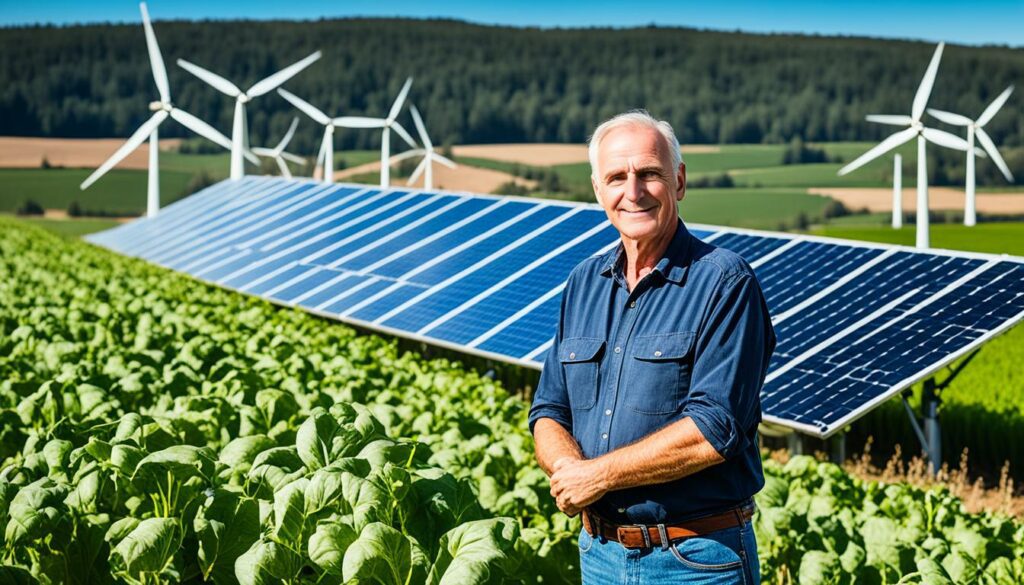
Back in the late 1980s, four farmers in Montana saw their wheat prices drop. They also found the cost of fertiliser going up and their soil eroding. Seeing this, they switched to growing organic pulse crops. Thus, Timeless Seeds began.
They started by focusing on lentils. They knew these crops could make them money and help their soils too. But to grow, they had to do many things.
They used old buildings and got help from their neighbours to build a plant for their crops. Soon, their hard work paid off. The pulse crops not only made money but also showed how good farming can turn poor soil into rich land.
Timeless Seeds’ success has made them known worldwide. Their story shows how important it is to change and find new ways in farming. They have shown us that farming can be both strong and kind to the planet.
This success is not just about farming. It’s about smart change in tough times, like dealing with climate change. Timeless Seeds’ way of farming is a good example for us all to follow. It shows how we can keep growing food while taking care of the earth for our kids.
To make agriculture more resilient, we need smart policies. These policies should push for practices that are good for the environment and help adapt to climate change. The Agricultural Resilience Act (ARA) is key. It aims to make farming communities stronger by boosting their resilience.
Introduced by Rep. Chellie Pingree, the Agricultural Resilience Act is a big step for the sustainability and resilience in farming. It sets a bold goal of the U.S. having no net greenhouse gas emissions from agriculture by 2040. This will be done by focusing on things like keeping the soil healthy, managing livestock well, saving energy, and reducing food waste. The idea is to fight climate problems and build a strong future for farming.
Having enough money and good incentives from the government is key to making the Agricultural Resilience Act work. This includes financial help for farmers who want to use sustainable methods and new technologies. These efforts aim to help farmers be better prepared for climate change and its effects on their businesses.
Creating resilience in farming communities requires a full approach, involving everyone. By getting the community involved, we can make the most of initiatives led by the community. We will also make use of networks that work together for better results. This way, we can tackle the tough issues in farming effectively.
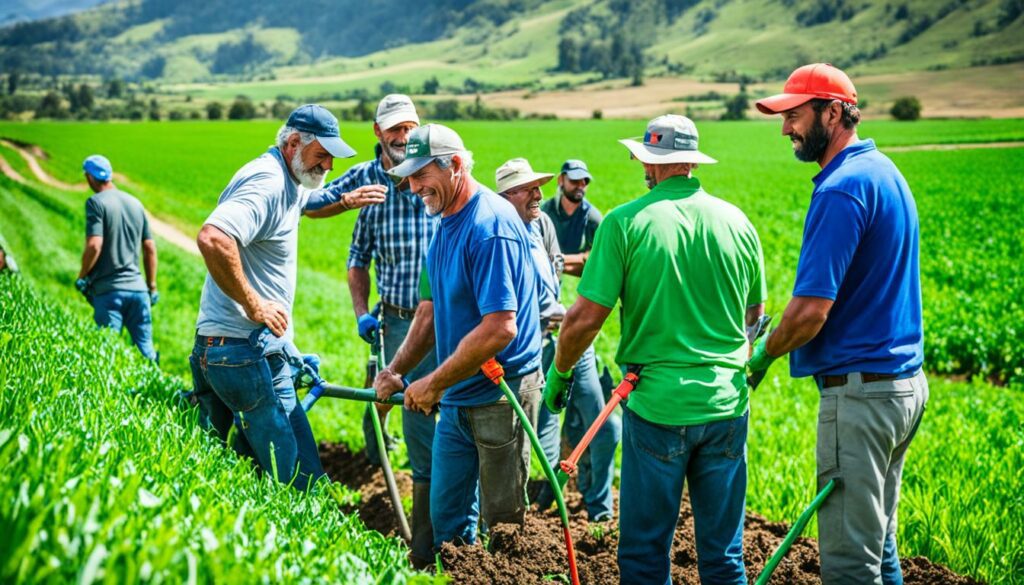
Farmers must work together within their own and other communities to be more resilient. An example like Syntropic Farming shows that adding more activities can make farms stronger. By trying new things and working together, farmers can use different ways to overcome problems. This means they are not only relying on old ways to do things.
Collaboration also means that they share what they know and what they have. This makes the whole group stronger and able to face challenges as one.
Having open talks and focusing on specific issues are key parts of community resilience. Take the San Leandro initiative, for example. They plan to plant 5,000 trees with a big grant from CalFire. This project targets places with less money and more pollution.
Such projects show how working together can solve big problems. They also help with sharing information and finding common solutions. This way, everyone feels a part of making things better.
Hubs for resilience also help a lot. They make it easier to adapt and offer important help during emergencies. These places aim to be fair and let the community lead. They are good examples of how to build resilience everywhere against climate change. That shows how important strong leadership is.
Lastly, being willing to learn and adjust is key to success. Communities must keep getting better at what they do. This way, they can tackle problems and find new ways to grow and improve.
Today, the agriculture sector needs to embrace technological advancements in sustainable agriculture. This is essential for farming to be more resilient. New technologies help us use resources better, manage pests, and diseases, and equip farmers to make smart choices.
Vertical farming is a shining example. It can cut water use by 70% to 95% when compared with traditional methods. This technique saves water and reduces the food industry’s carbon footprint. It does this by growing local produce closer to where it’s needed, cutting down long transport journeys.
Siemens and 80 Acres Farms working together show the impact of high-tech automation. Siemens’ tech makes plant growing systems more efficient in South Africa. It helps reduce waste and makes the food supply chain more dependable. This is done by keeping farming conditions just right, which prevents crops from failing.
Vertical farming plays a vital role in advancing sustainable agriculture. By using data carefully, farmers can make their methods more effective and adaptable. This not only benefits our environment but also prepares us to feed a growing world population.
| Benefit | Impact | Example |
|---|---|---|
| Water Conservation | 70% to 95% less water usage | Vertical Farming |
| Optimised Production | Increased efficiency | Siemens & South African Agriculture |
| Reduced Carbon Footprint | Minimised transportation needs | Locally Grown Produce |
| Decreased Food Wastage | Lower crop failure risks | Controlled Environment Cultivation |
Farming communities need to keep learning and adapting to face new conditions. Education programmes help farmers gain the skills and knowledge they need. These programmes connect research to real farm life, encouraging new ways of farming.
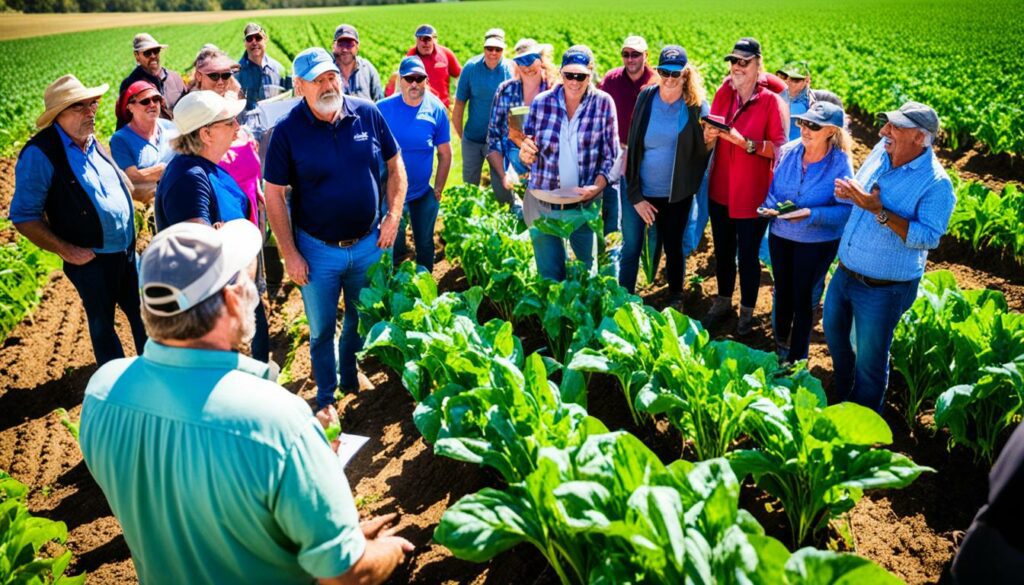
Extension programs share the latest farming research and top methods. Taking part helps farmers get advice, new methods, and meet others in farming. This teamwork helps in dealing with issues like climate change and pests.
Series for professional growth focus on risk, community work, and resilience. They add things like agri-tourism to boost incomes and inspire new ideas. The coming Spring 2024 Live Cohort costs $100. It lasts from May to June with five online modules. Done at your pace, it needs 1-2 hours a week for 10 weeks. Farmers get special help to face future challenges.
Dr. Clara Nicholls and Dr. Miguel Altieri, with other experts, teach in the programme. It was praised with an “Outstanding Project” award. Farmers join for free, but others are asked to donate. Everyone gets support through resources like the Climate Chronicles Podcast and Wildfire Workbook for a strong farming future.
Being smart with natural resource management for resilience matters a lot in farming. It shows how soil, water, and nature are vital. Farmers who handle these well can see big wins. For example, using many different crops in fields helps the soil. This makes everything better and more stable.
Good soils can take on a lot, like too much water or heat. They make it so farmers don’t have to water as much. This saves money and makes the farm’s products better. It also helps the environment stay healthy.
To face climate change in farming, you need to look at many things. This includes nature, people, and money. A strong community helps a lot. It brings help, work, and things to sell, making farms more successful.
It also takes smart, up-to-date farmers to succeed. They need to see what’s coming and be ready. Having good tools and tech really supports them too.
Finances must stay steady for farms to do well. Using all kinds of resources makes farms stronger. This helps them fight against future problems.
Selling in many ways makes farms more secure. Talking to and selling to people nearby is great. It spreads out the risks and brings in more money.
Careful managing natural resources for resilience helps farms do well in tough times. It’s about making farms that can face any challenge and come out on top.
| Resource Type | Benefits for Resilience |
|---|---|
| Healthy Soils | Buffers rainfall, reduces irrigation, cuts costs |
| Diversified Production Systems | Enhances product quality, maintains biodiversity |
| Supportive Communities | Provides goods, services, labour, and market access |
| Financial Stability | Sustains businesses, enhances living standards |
| Infrastructure and Technologies | Supports effective farm management |
Risk management is key for those in farming due to many unknowns. These include changes in climate, soil erosion, and economic swings. With strong financial plans and flexible ways of growing, farmers build stronger farms. These can withstand different challenges better.

Creating a solid financial plan is critical in farming. It includes saving, budgeting, and smart investments. This way, farmers can handle ups and downs in markets and the effects of climate change.
Such planning helps lessen the blow of big, unexpected events. Now, these events are more common due to climate change. It keeps farms running, no matter what.
To make farms more resilient, they need to be adaptable. This means growing a variety of crops, using eco-friendly methods, and the latest tech. With these measures, farmers can adjust to hotter temperatures, less predictable rain, and other environmental shifts.>
| Strategy | Benefit | Impact |
|---|---|---|
| Financial Planning | Mitigates market volatility | Secures farming operations financially |
| Adaptive Farming Methods | Enhances flexibility in production | Improves resilience to climatic changes |
Combining good financial planning with adaptable growing methods is vital. It protects farms from tough conditions and helps farmers continue their work. As the future might bring more severe weather and a global drop in harvests by 2050, these steps are more important than ever. This future is why farmers must act now.
For farming to be economically sustainable, farmers need to earn from different sources and find new markets. This way, they can lower risks and become more stable over time. It’s crucial in a changing agricultural world.
To have a steady income in agriculture, it’s key to look into other money sources. This could be through agritourism or making products that add value. Such efforts give farmers more money, reduce a reliance on old ways, and bring new chances to make a living.
The success story of The Ever-Growing Family Farm is a great example. They changed their rice types and how they grow it over seven years. These changes have made their farm more diverse and financially strong. They focus on adding value to what they produce and involve their community. This approach has made their income more secure.
It’s also critical to reach different markets for a stable farm income. Direct selling to consumers can be very profitable. And exploring specific markets can lead to more money and help against sudden market changes.
Using methods like IPM and agroforestry can make a farm more financially sound. For example, having both livestock and crops can boost the farm’s income. And planting fruit or nut trees together with usual crops can add more to what the farm earns.
| Strategy | Benefits |
|---|---|
| Agritourism | Provides supplementary income and attracts visitors |
| Value-added Processing | Increases product value and market competitiveness |
| Community Supported Agriculture (CSA) | Ensures a stable income source through member subscriptions |
| Integrated Pest Management (IPM) | Reduces chemical pesticide use by 20% and controls pest population effectively |
| Agroforestry | Generates additional 15% income through fruit or nut crops |
In conclusion, for farms to do well, they must try new ways of making money alongside traditional farming. This helps in staying strong and stable in the farming world.
Support systems are vital for farming communities. They help them tackle many challenges. These systems provide tools and help when they’re needed.
I looked at 30 research papers from 2010-2015. They focused on the support needed in farming. Experts talked about a special type of learning that helps people and the land withstand hard times. The Stockholm Resilience Centre says this skill is vital. It helps communities stay strong when things get tough.
There’s been a big change in how we think about helping rural places adapt. Adger (2000) talks about this. He says we need to help places change and grow, not just go back to how they were. This new way focuses on the whole community getting better, not just fixing small problems.
“Resilience is described as the ability of a system to absorb disturbance and re-organise while undergoing change so as to still retain essentially the same function, structure, and identity.” — Stockholm Resilience Centre
But, some don’t think this new way is the best. They worry if farming areas grow too much, it might hurt the land. They want to make sure growing and changing doesn’t make problems worse. A recent survey in the Noosa area shows how important good support is for farmers.
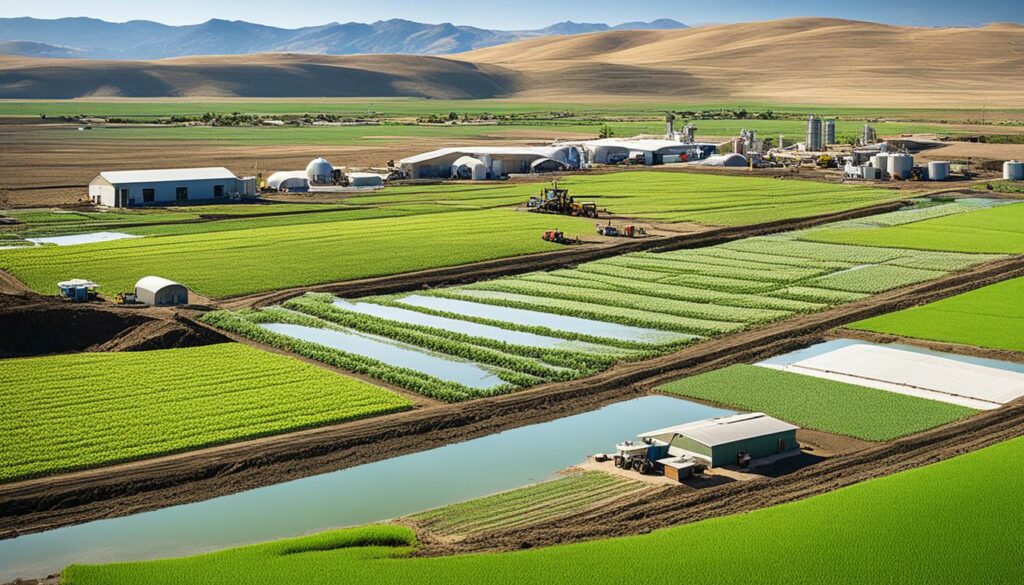
In Noosa, many people who live in rural areas own the land they live on. This shows how farming areas need strong connections to help with things like land use and growing crops in different ways.
Looking at Hemudu, support for farmers is clearly linked to how well the area does. Good support means the land is looked after and used in smart ways. This helps the community and the land stay healthy and strong.
Resilience is key in farming communities. They face many pressures from modern agriculture. It’s vital to protect these areas from current and future challenges. The loss of 2,000 acres of farming land every day highlights the need for resilience in rural areas.
Between 2001 and 2016, 11 million acres of farming land changed or disappeared. This fast change puts our farming landscapes at risk. Saving 1.7 million acres since 1996 through ACEP shows we can fight back. But, we could lose another 18.4 million acres by 2040. This warns us to act fast.
In 2020, climate disasters caused $3.6 billion in losses to crops and rangelands. This shows how exposed agriculture is to nature’s changes. Over 40% of farmland might change owners by 2035. This is a chance to make our farming sectors more resilient.
The Agricultural Resilience Act (ARA) targets zero greenhouse gas emissions by 2040. It also plans to grow cover crops and better grazing management. These actions will make rural farming more resilient. They will help keep the soil healthy, lower emissions, and save resources.
Support is also essential. From 2010-2020, EQIP funded only 30% of its applications. This shows a big need for more help. Programs for protecting agricultural land find that 70% of participants have a conservation plan. Having a good plan is crucial for long-term resilience.
Pushing for more on-farm renewable energy by 2040 can help farming systems become stronger. By cutting food waste by 75% until then, we can support these aims. This will lead to a more sustainable and resilient system for agriculture.
Building resilience in rural farming is something we must keep working on. It ensures a bright future for our farming communities. By encouraging new ideas, supporting policies, and engaging with the community, we create stronger farming systems. These will thrive, even in hard times.
The journey to making farms stronger is tough but vital. The work of farmers like Nfamara Badjie and Dawn Hoyte at Ever-Growing Family Farm shows us the importance of working together, new ideas, and lasting ways of farming. They began in 2014, showing how research and talking with the community can improve farming. They used different rice types and had ducks to keep the fields clean.
They started in New York, where the weather is tough for crops. Cornell University and grants, like the SARE Farmer grant (FNE19-933), helped a lot. These groups showed that planting crops the Jola way can work even in short growing seasons. Community support and raising money online for tools have helped the farm stay strong.
To make farming more able to face challenges, we need to think about many things. This should include how we live and work, financial matters, and the world around us. Facing issues such as climate change and having fewer young farmers needs a strong response. Farms like Ever-Growing are not just getting by; they’re doing really well by caring for people, fairness, and local culture. Looking forward, keeping up these good farming practices, with help from laws, community efforts, and new ideas, is key to a great future in farming.
Building resilience in farming communities is key. It helps farms be more sustainable, use natural resources wisely, and be ready to change in tough times. This is important to take on challenges from the environment, economy, and society.
Key strategies for farming resilience include crop rotation and cover cropping. These methods keep the soil healthy and support plant variety. They also help use resources better and make farms stronger against bad weather.
Building resilience in rural areas means working together. By talking about issues in public forums, communities can find solutions as a group. This helps everyone share the work and stand together against hard times in farming.
Farming faces tough challenges like changing climate, soil wear, and controlling pests. To overcome these, farmers must move to more resilient farming methods. This ensures their farms can keep going strong.
Sustainable practices like crop rotation and conservation tillage are great for the land. They protect nature, keep the soil rich, and encourage bio-diversity. These methods make farms better able to cope with change.
Timeless Seeds in Montana is a great example. When faced with tough times, the farmers switched to growing organic pulses. They even set up their own processing plant. Now, they have a sustainable business that’s doing well.
Policy is vital in helping farming become more resilient. The Agricultural Resilience Act (ARA) is one such effort in the U.S. It focuses on important issues like climate change and soil health. Its goal is to make U.S. agriculture have no net greenhouse gas emissions by 2040.
Technology makes farming more resilient by improving how resources are used and by fighting off pests. Things like precision farming and data tools are very helpful. They let farmers make smart choices based on solid information.
Education and training help farmers learn new ways to be resilient. Programs and series provide them with the latest methods and teach them how to manage risks. This makes them better prepared for the future.
Looking after the soil and water well, along with keeping a range of plants and animals is essential. These steps protect the environment and keep farming going strong. They ensure farms are productive for many years.
Farmers can handle risks by planning well and being ready to change how they farm. Good financial plans help in uncertain markets. Being able to change how they produce lets farmers respond to challenges in the environment.
To make farming’s economy strong, it’s good to have different ways to make money and sell goods. Things like agritourism and adding value to what’s grown can help. They make the farm less dependent on a single market, which is safer and more stable.
Local support, like from cooperatives and government programmes, are very helpful for farmers. They offer knowledge and help that makes the whole community stronger together. This makes it easier for farms to face challenges and even grow through changes in the sector.
Making agriculture more resilient keeps it strong and ready for future needs. It helps farming stay sustainable and balanced against global challenges. By being more adaptable, farming can look after the planet and keep feeding people without harm.